How shallow water affects Manoeuvring?
In shallow waters, manoeuvring has very many facets and it is necessary that we understand the same clearly. Such knowledge helps us to understand the effects of interactions including squat and the sluggish way the ship handles in such waters. It also helps us to avoid them and plan for them.
Having understood the general manoeuvring characteristics of a ship in deep and still water, let us understand the effects of shallow waters and narrow channels on ship handling.
Hydrodynamic interaction continues to be a major contributory factor in marine casualties and hazardous incidents. Typical situations involve larger vessels overtaking smaller ones in narrow channels where interaction has caused the vessels to collide and, in one case, the smaller vessel capsized with loss of life.
Situations in which hydrodynamic interaction is involved fall into the following categories: –
(a) Vessels, which are attempting to pass one another at very close range, particularly when in the confines of a narrow channel.
(b) Vessels, which are manoeuvring in very close company for operational reasons, particularly when the larger vessel has a small under-keel clearance.
(c) Vessels with a small under-keel clearance, when approaching an enclosed basin stop rapidly, resulting in unexpected sheering. Included in this category is the reduced effect of accompanying tugs, experienced in these circumstances.
Passing Vessels
When vessels are passing, there are two situations:
(i) Overtaking and
(ii) The head-on encounter.
Overtaking
Interaction is most likely to prove dangerous when two vessels are involved in an overtaking manoeuvre. One possible outcome is that the vessel that overtaken may take a sheer into the path of the other. Another possibility is that when the vessels are abeam of one another the bow of each vessel may turn away from the bow of the other causing the respective sterns to swing towards each other. An overall strong attractive force between the two vessels due to the reduced pressure between the underwater portions of the hulls may also occur. There are other possibilities, but the effect of interaction on each vessel during the overtaking manoeuvre will depend on a number of factors including the size of one vessel relative to the other, the smaller of the two vessels feeling the greater effect.
Head On Encounter
In this situation interaction is less likely to have a dangerous effect, as generally the bows of the two vessels will tend to repel each other as they approach. However, this can lead indirectly to a critical situation. It may increase any existing swing and secondary interaction such as bank-rejection from the edge of a channel may complicate the situation. In all cases, it is essential to maximise the distance between the two vessels. The watchkeeper on the larger vessel should bear in mind the effect on adjacent smaller vessels and take necessary care when manoeuvring.
Key Points
► Understand that sudden sheering may occur when passing another vessel at close range.
► Appreciate the need to reduce speed in narrow channels.
► Be aware of the dangerous effects on tugs when manoeuvring close to larger vessels.
► Be aware that unexpected turning moments may result when stopping in shallow, confined basins.
► Appreciate the need to make appropriate allowances for squat.
► Note the results of laboratory work.
Interaction In Narrow Channels
When vessels intend to pass in a narrow channel, whether on the same or opposing courses, it is important that to do so at a low speed. The speed should be sufficient to maintain control adequately but below maximum for the depth of water so that in an emergency extra power is available to aid the rudder if necessary. If a reduction in speed is required, do it in good time before the interaction affects the ship. A low speed will lessen the increase in draught due to squat as well as the sinkage and change of trim caused by interaction itself. Depending upon the dimensions of both the vessel and the channel, speed may have to be restricted. When vessels are approaching each other at this limiting speed, they shall experience magnified effects of interaction. Therefore, a further reduction in speed may be necessary. Those in charge of the handling of small vessels should appreciate that more action may be required on their part when passing large vessels which may be severely limited in the action they can take in a narrow channel. Regardless of the relative size of the vessels involved, an overtaking vessel should only commence an overtaking manoeuvre after the other vessel has agreed to the manoeuvre.
Manoeuvring At Close Quarters
When vessels are manoeuvring at close quarters for operational reasons, the greatest potential danger exists when there is a large difference in size between the two vessels such as the attending tug and a large vessel. A dangerous situation is most likely when the tug, having been manoeuvring alongside the vessel, moves ahead to the bow to pass or take a towline. Due to changes in drag effect, especially in shallow water, the tug has first to exert appreciably more ahead power than she would use in open water to maintain the same speed and this effect is strongest when she is off the shoulder.
At that point, hydrodynamic forces also tend to deflect the tug’s bow away from the vessel and attract her stern; but as she draws ahead, the reverse occurs, the stern is strongly repulsed and the increased drag largely disappears. There is thus a strong tendency to develop a sheer towards the vessel. Unless the helm (which will have been put towards the vessel to counter the previous effect) immediately reversed and engine revolutions rapidly reduced, the tug may well drive itself under the vessel’s bow.
A further effect of interaction arises from the flow around the larger vessel acting on the underbody of the smaller vessel causing a consequent decrease in effective stability, and thus increasing the likelihood of capsize if the vessels come into contact with each other.
The strength of hydrodynamic interaction varies approximately as the square of the speed. Therefore, carry out this manoeuvre at slow speeds. If vessels of dissimilar size are to work in close company at any higher speeds then it is essential that the smaller one keeps clear of the hazardous area off the other’s bow.
Stopping In Shallow Basins
A vessel in very shallow water drags a volume of water astern, which can ibe as much as 40% of the displacement, When the vessel stops this entrained water continues moving and when it reaches the vessel’s stern, it can produce a strong and unexpected turning moment, causing the vessel to begin to show unexpectedly. In such circumstances accompanying tugs, towing on a short line may sometimes prove to be ineffective. The reason for this is that the proximity of the vessel’s hull and small underkeel clearance reduces or even cancels the tug’s thrust. This causes the tug’s wash to be laterally deflected reducing or even nullifying the thrust. The resultant force on the hull caused by the hydrodynamic action of the deflected flow may also act opposite to the desired direction.
Effect on the Rudder
It should be noted that in dealing with an interaction situation the control of the vessel depends on the rudder which in turn depends on the flow of water round it. Stopping the engines reduces the effectiveness of the rudder. When a vessel is moving ahead putting the engine astern can render the rudder ineffective at a critical time. In many cases, a momentary increase of propeller revolutions when going ahead can materially improve control.
Situations involving hydrodynamic interaction between vessels vary. When a vessel is moving through the water there is a positive pressure field created at the bow, a smaller positive pressure field at the stern and a negative pressure field amidships. The effects of these pressure fields can be significantly increased where the flow of water round the vessel is influenced by the boundaries of a narrow or shallow channel and by sudden local constrictions (e.g. shoals), by the presence of another vessel or by an increase in vessel speed.
An awareness of the nature of the pressure fields round a vessel moving through the water and an appreciation of the effect of speed and the importance of rudder action should enable a vessel handler to foresee the possibility of an interaction situation arising and to be in a better position to deal with it when it does arise. During passage planning depth, contours and channel dimensions should be examined to identify areas where interaction may be experienced.
Squat
Squat is a serious problem for vessels, which have to operate with small under-keel clearances, particularly when in a shallow channel confined by sandbanks or by the sides of a canal or river. The “Mariners’ Handbook” (NP 100) contains further information on squat. The Admiralty Sailing Directions also give specific advice for squat allowances for deep draught vessels in critical areas of the Dover Strait.
Shallow waters in this context mean depths, which are not more than twice the draft.
Squat effect – Effect on Draft & Trim
If one were to be in a position to read the drafts when a ship was in motion (fortunately it is not possible and do not attempt this!), the draft of the ship would increase as the speed increases. The full impact of this phenomenon was fully understood only after World War II. However, when the larger ship came into operation such ships actually touched bottom although there were sufficient depths available for the draft she was drawing. A lot of studies and investigation later it has been positively proved that ship squats in the water and such squat increases with speed and other factors such as the ratio of the depth to draft and the co-efficient of fineness of the ship.
Various hydrodynamics theories have been put forward and tested
► One such theory states that as thc(vessel is steaming through shallow water the water pushed in the forward part needs replacement. In deep waters, this water is drawn from all over but in shallow water, the water is not replaced and eventually the ship settles down to a deeper draft) (It appears that this is true for all waters but it is more predominant in shallow waters.)
► The other theory is that the water at the bottom of the ship rushes past at a faster speed than the water layer at surface. This creates a suction effect at the bottom and causes the ship to settle down to a deeper draft, called squat.
► When a ship enters shallow waters it experiences a blocking effect, which reduces the sped due to hydrodynamic effect on the hull form of the ship. You have come across the tern Co-efficient of fineness. This is the ratio of the actual volume of the ship at the designed draft divided by the volume of a block having the same length, breadth and depth.
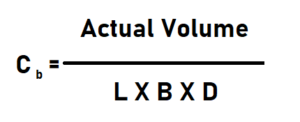
For most cargo ships, the Cb is about 0.70 and for faster ships such as container ships the Cb would be from 0.55 to about 0.65. For passenger ships it could be lower.
The squat effect is because of a blocking effect, which causes a loss of speed in shallow water. Simultaneously this loss in speed increases the squat. Blocking effect however is apparent in shallow waters and is the cause of the reduction in ship’s speed.
For example, a VLCC could experience a reduction of speed to about 10 knots in shallow water when it would have been steaming at 15 knots in deep waters. Similarly, a container vessel could drop her speed from 22 knots to 15 knots in similar circumstances.
Factors affecting squat
When considering the squat effect we may have to take in to account another parameter. This is the ratio H / T. The water depth being (H) and the even keel draft being (T).
As the ratio reduces to less than 1.5, the squat increases appreciably and needs to be taken into account.
Speed is yet another aspect that determines the quantum of the squat. The lesser the speed the lesser the squat. Some ships squat at the stern while some even squat at the bow. These tendencies are now worked out for each ship and you may find this information on board your ship.
Conclusion
► Squat eff6ct is appreciable when depth of water is less than 1.5 times the draft.
► Squat effect increases with the ship’s speed.
► Squat is related to Cb.
Effect on steering
The steering in shallow water is affected in two ways. They are:
► For a given helm angle, the rate of turning is slower, thus sluggish response to helm.
► Loss of speed with hard over wheel is less as compared to deep waters.
► It has also been observed that due to the blocking effect at the bow, the pressure may increase on one side, and the vessel may suddenly sheer to that side where comparatively low pressure exists. This sheer has caused a number of accidents and since not enough was known about it, such sheer has been considered a% failure of steering gear.
Effect on heading & athwartship positioning
When a ship is proceeding in a narrow channel, the higher speed of water on the bank and lower speed off the bank causes the vessel to sheer towards the bank pushing the ship bodily onto the bank. This effect is known as Bank Suction.
This can be explained as follows, Waters from all over fills up partial vacuum created behind the ship. Due to similar reasons as stated above,water from bank side tends to fill more rapidly than the water body on the other side, creating a higher relative speed of water. This results in the drop of water level on the bank side as compared to the open side.
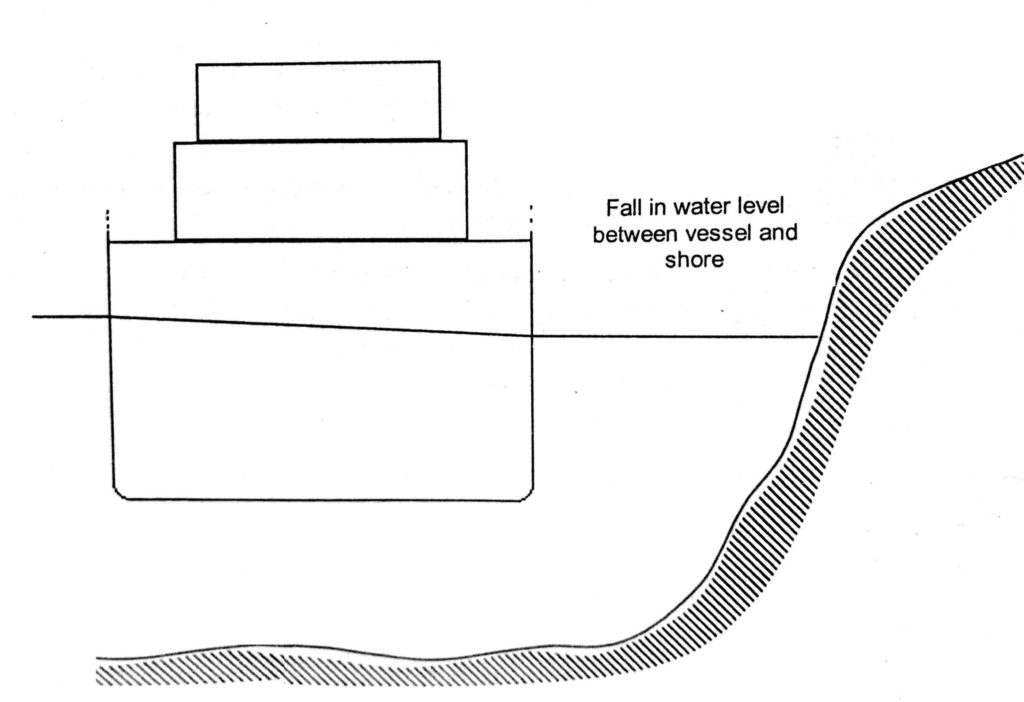
Bank suction force in the vicinity of stem is less than the force applicable along rest of the ship’s length. Net effect being that the parallel body experiences a suction effect while the bows do not, thus causing the bows to sheer away from the bank. This sheering away of bow from bank, as if water is cushioning the fore part of the ship, is called Bow Cushion.
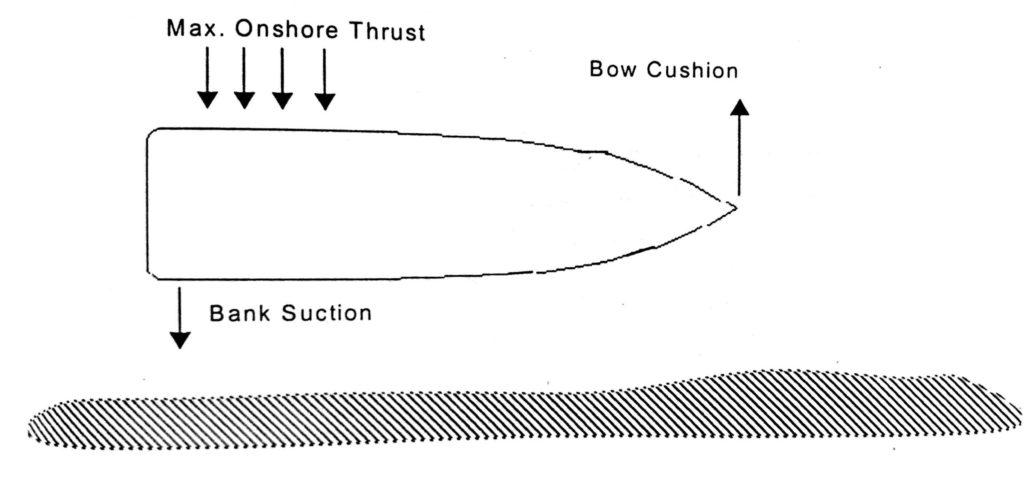
Interaction
When two ships are passing or overtaking each other at a relatively close distance a phenomenon called the “interaction” takes place. This causes the vessels to be swung off-course and a lateral displacement towards or away from each other.
Let us take the case of vessel ‘A’ overtaking vessel ‘B’. As the bow of ‘A’ approaches the stern of the water pressure between the two vessels tends to push the stern of the vessel ‘B’ away from the vessel ‘A’. Simultaneously the bow of ‘B’ will also swing into the path of vessel ‘A’, resulting in a very dangerous situation (Shown in below fig 1)
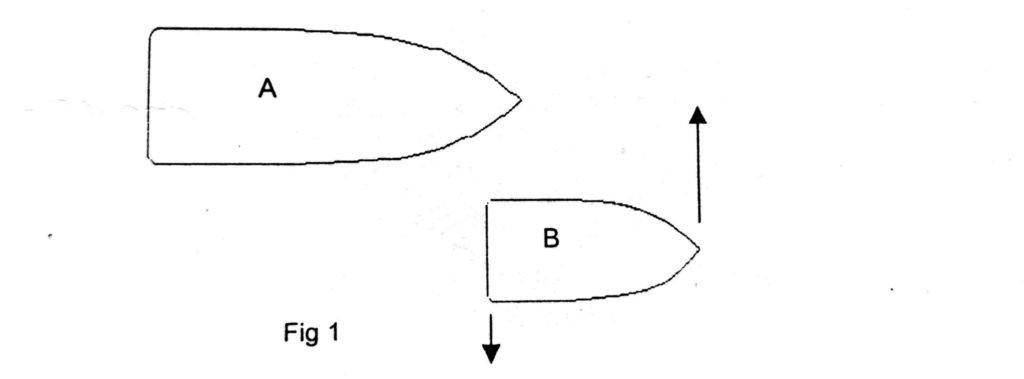
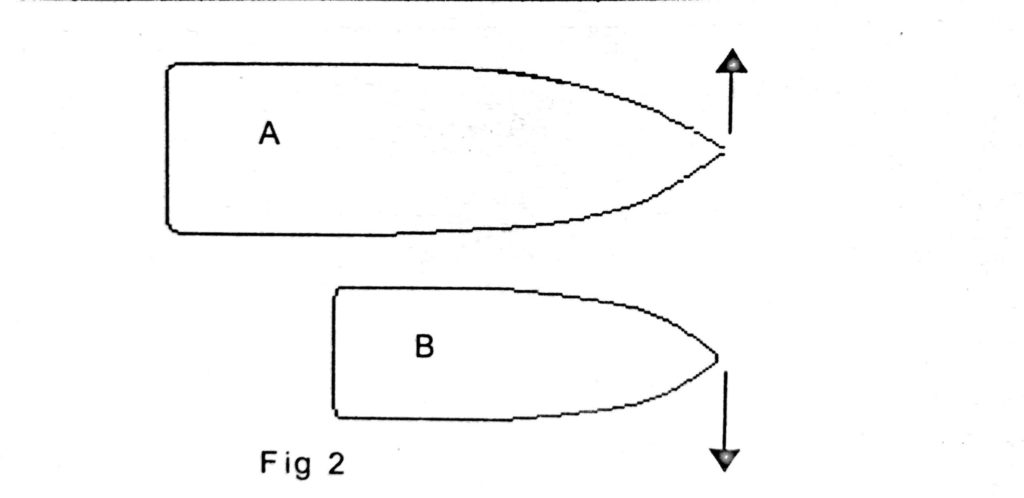
When both vessels are parallel to each other with their bows abreast of each other the water rushing between the two vessels have higher speeds than the water on the outer side of both vessels. This causes a cushion effect at the bows and swings the stern of both vessels towards each other. Simultaneously the two hulls may experience a suction effect and draw closer (fig 2).
However, the most dangerous situation occurs when the midship body of the overtaking vessel is abreast of the bow of the overtaken vessel. Here the bows of the overtaken vessel sheer towards the overtaking vessel. This sheer could cause a collision if the vessel being overtaken is smaller than the other is, and both are proceeding at considerable speed (fig 3).
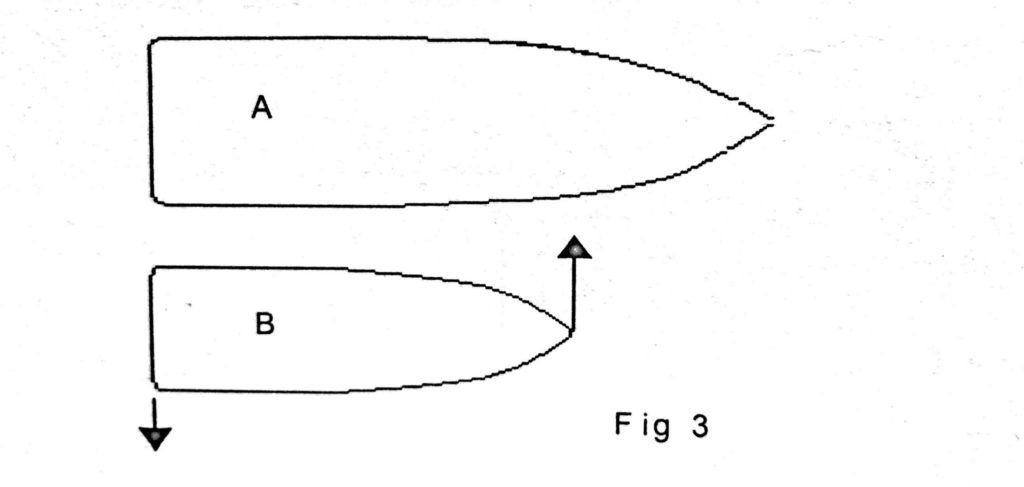
A safe distance should therefore be maintained while passing other vessels especially in shallow waters. The danger is much higher when:
► Relative speed between two ships is high.
► Distance between the two ships is small, and
► One of the vessels is a smaller vessel
Results of Laboratory Work
Extensive laboratory work was carried out on the combined effects of hydrodynamic interaction and shallow water (Le, depth of water less than about twice the draught) and the following conclusions, which borne out the practical experience, are among those reached:
► Shallow waters amplify the effects of interaction (and of bank suction and rejection).
► The effectiveness of the rudder reduces in shallow water and depends very much on adequate propeller speed when going ahead. The minimum revolutions needed to maintain steerage way may therefore be higher than are required in deep water.
► However, avoid relatively high speeds in very shallow water due to the danger of grounding because of squat. Draught increases well over 10% are observed at speeds of about 10 knots, but when speed is reduced squat rapidly diminishes. It has also been found that additional squat due to interaction can occur when two vessels are passing each other.
► The transverse thrust of the propeller changes in strength and may even act in the reverse sense to the normal in shallow water.
► Vessels may therefore experience quite marked changes in their manoeuvring characteristics as the depth of water under the keel changes. In particular, when the under-keel clearance is very small a marked loss of turning ability is likely.
► A large vessel with small under-keel clearance, which stops in an enclosed basin, can experience strong turning forces caused by the mass of entrained water following it up the approach channel.
Examples of Accidents Caused By Hydrodynamic Effects
1) Overtaking In a Narrow Channel
This casualty concerns a fully loaded coaster of 500 GT, which was being overtaken by a larger cargo vessel of about 13,500 GT. The channel in the area where the casualty occurred was about 150 metres wide and the lateral distance between the two vessels as the overtaking manoeuvre commenced was about 30 metres. The speeds of the two vessels were initially about 8 and 11 knots respectively. When the stem of the larger vessel was level with the stern of the smaller vessel the speed of the latter vessel was reduced. When the bow of the smaller vessel was level with the midlength point of the larger vessel the bow started to swing towards the larger vessel. The helm of the smaller vessel was put hard to starboard and speed further reduced. The rate of swing to port decreased and the engine was then put to full ahead but a few seconds later the Port side of the smaller vessel, in way of the break of the foc’sle head, made contact with the starboard side of the larger vessel. The angle of impact was about 25° and the smaller vessel remained at about this angle to the larger vessel as she first heeled to an angle of about 20° to starboard and shortly afterwards rolled over and capsized, possibly also affected by the large stern wave carried by the larger vessel into which the smaller one entered, beam on, as she dropped back.
2. Manoeuvring With Tugs
A casualty involving a 1,600 GT cargo vessel in ballast and a harbour tug, which was to assist her to berth, illustrates the second category. The mean draughts of the vessel and the tug were 3 and 2 metres respectively. The tug was instructed to make fast on the starboard bow as the vessel was proceeding inwards, and to do this she first paralleled her course and then gradually drew ahead so that her towing deck was about 6 metres off, abeam of the vessel’s forecastle. The speed of the two vessels was about 4 knots through the water, the vessel manoeuvring at slow speed and the tug, in order to counteract drag, at / 4 speed.
As the tow line was being passed, the tug took a sheer to port and before this could be countered, the two vessels touched, the vessel’s stern striking the tug’s. port quarter. The impact was no more than a bump but even so, the tug took an immediate starboard list, and within seconds capsized. One man drowned.
3. Stopping in a Shallow Basin
VLCC was nearing an oil berth in an enclosed basin, approaching a narrow channel is in the third category. The VLCC stopped dead in the water off the berth while tugs made fast fore and aft. An appreciable time after stopping the VLCC began to turn to starboard without making any headway. The efforts of the tugs to prevent the swing proved fruitless and the starboard bow of the tanker struck the oil berth, totally demolishing it.